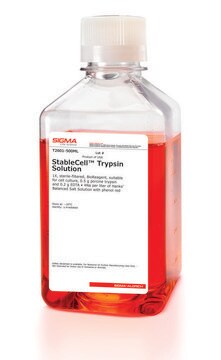추천 제품
애플리케이션
The typical use for this product is in removing adherent cells from a culture surface. The concentration of trypsin necessary to dislodge cells from their substrate is dependent primarily on the cell type and the age of the culture. It can be used with endothelial cell cultures.
생화학적/생리학적 작용
Trypsin cleaves peptides on the C-terminal side of lysine and arginine residues. The rate of hydrolysis of this reaction is slowed if an acidic residue is on either side of the cleavage site and hydrolysis is stopped if a proline residue is on the carboxyl side of the cleavage site. The optimal pH for trypsin activity is 7-9. Trypsin can also act to cleave ester and amide linkages of synthetic derivatives of amino acids. EDTA is added to trypsin solutions as a chelating agent that neutralizes calcium and magnesium ions that obscure the peptide bonds on which trypsin acts. Removing these ions increases the enzymatic activity.
Serine protease inhibitors, including DFP, TLCK, APMSF, AEBSEF, and aprotinin, amongst others, will inhibit Trypsin.
Serine protease inhibitors, including DFP, TLCK, APMSF, AEBSEF, and aprotinin, amongst others, will inhibit Trypsin.
성분
Trypsin consists of a single chain polypeptide of 223 amino acid residues, produced by the removal of the N-terminal hexapeptide from trypsinogen which is cleaved at the Lys - lle peptide bond. The sequence of amino acids is cross-linked by 6 disulfide bridges. This is the native form of trypsin, beta-trypsin. BETA-trypsin can be autolyzed, cleaving at the Lys - Ser residue, to produce alpha-trypsin. Trypsin is a member of the serine protease family.
주의사항
This product is stored frozen between -10 and -40°C. Repeated cycles of freezing and thawing should be avoided.
적합한 제품을 찾을 수 없으신가요?
당사의 제품 선택기 도구.을(를) 시도해 보세요.
관련 제품
제품 번호
설명
가격
Storage Class Code
12 - Non Combustible Liquids
WGK
nwg
Flash Point (°F)
Not applicable
Flash Point (°C)
Not applicable
이미 열람한 고객
Carlos Pantoja et al.
Current biology : CB, 30(18), 3647-3656 (2020-08-09)
Interindividual variation in behavior and brain activity is universal and provides substrates for natural selection [1-9]. Selective pressures shift the expression of behavioral traits at the population level [10, 11], but the accompanying changes of the underlying neural circuitry have
Ling Xue et al.
The Journal of nutritional biochemistry, 19(5), 336-344 (2007-08-21)
3,3'-Diindolylmethane (DIM), a major condensation product of indole-3-carbinol, exhibits chemopreventive properties in animal models of cancer. Recent studies have shown that DIM stimulates interferon-gamma (IFN-gamma) production and potentiates the IFN-gamma signaling pathway in human breast cancer cells via a mechanism
Liqin Cao et al.
PLoS genetics, 5(12), e1000756-e1000756 (2009-12-10)
In mammals, observations of rapid shifts in mitochondrial DNA (mtDNA) variants between generations have led to the creation of the bottleneck theory for the transmission of mtDNA. The bottleneck could be attributed to a marked decline of mtDNA content in
Alena Shkumatava et al.
Genes & development, 23(4), 466-481 (2009-02-26)
MicroRNAs (miRNAs) are small noncoding RNAs that direct post-transcriptional repression of protein-coding genes. In vertebrates, each highly conserved miRNA typically regulates hundreds of target mRNAs. However, the precise relationship between expression of the miRNAs and that of their targets has
Jessica Rea et al.
Cancers, 13(15) (2021-08-08)
The impact of protein-coding genes on cancer onset and progression is a well-established paradigm in molecular oncology. Nevertheless, unveiling the contribution of the noncoding genes-including long noncoding RNAs (lncRNAs)-to tumorigenesis represents a great challenge for personalized medicine, since they (i)
자사의 과학자팀은 생명 과학, 재료 과학, 화학 합성, 크로마토그래피, 분석 및 기타 많은 영역을 포함한 모든 과학 분야에 경험이 있습니다..
고객지원팀으로 연락바랍니다.





